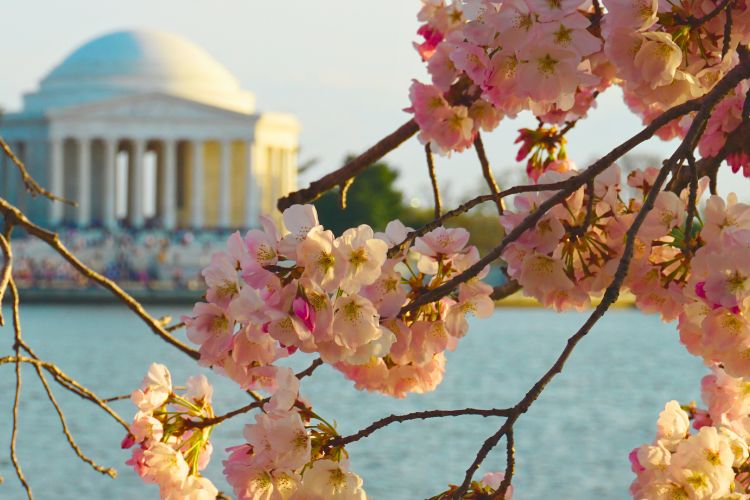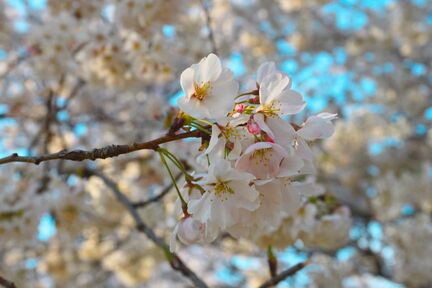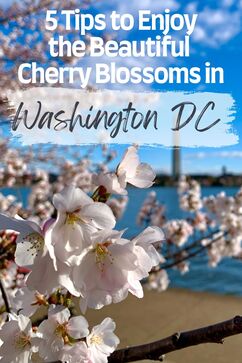|
Now that the cold days of winter are here to stay, it’s a perfect time to daydream about spring weather and seeing the iconic Washington DC Cherry Blossoms. Any good DC bucket list should include a spring visit to see these beautiful trees in full bloom. You’ll find the majority of the trees, along with the largest crowds, near the Tidal Basin and East Potomac Park. Here’s 5 tips and things that we have learned over the years to help make the most of viewing DC's Cherry Blossoms. Be sure to read our helpful Guide to Visiting Washington, DC for more resources and things to do while you are in town.
*Originally published in January, 2019, and updated for 2025.
*This post contains affiliate links; if you purchase something familyTravelsUSA may receive a small commission. As always, opinions are my own.
Two years later, the mayor of Tokyo authorized the shipment of roughly 3,000 trees. Later that year, the first two trees were planted on the Tidal Basin. It took another 7 to 8 years for the remaining trees to be planted around the Tidal Basin and East Potomac Park. Over 100 years later, more than 1.5 million people visit each year to walk among the cherry blossoms. Here’s a few things you can do to help make your visit to see the famous Washington DC Cherry Blossoms more enjoyable.
Dates for the National Cherry Blossom Festival are March 20, 2025 through April 13, 2025. The events will take place even if peak bloom has already been reached. The predicted peak bloom for 2025 is between March 28 - 31.
1. Be Flexible With the Timing of Your Visit
Every year in early March, the National Park Service will make their predictions as to the peak bloom time. This refers to the time period when 70 percent of the Yoshino cherry tree blossoms are open. Depending on the weather, the predictions and blooming time may change if there is a late snow or freeze, high winds, or heavy rain. Try to book a hotel with no change fees in the event you want to make a last minute change. If you have some flexibility, wait until late February or early March to check the blooming status before you confirm the dates of your trip. For planning purposes, check out Cherry Blossoms Facts and Figures from the National Park Service. It shows actual dates of peak bloom dating back to 1992. Some visitors might want to use that data to make a best estimate for the optimal time to visit. Typically peak bloom predictions will come out in early March. Check the National Park Service on social media for the latest updates. Note that peak bloom may not always coincide with the signature events found below.
2. Start Your Day Early or Plan to View in the Late Afternoon
Living in the DC suburbs, we are fortunate that we can be flexible when visiting the cherry blossoms. In past years, I’ve visited the blossoms very early in the morning on a Sunday. The lighting was nice for photos, and the crowds were minimal until about 10 a.m. If you can, visit during the week rather than on a weekend. Expect the largest crowds mid-day on Saturdays and Sundays, where it gets much harder to take pictures without other people in the background. Also consider other viewing perspectives, like from a kayak on the water. If you are interested in a ride on the popular pedal boats at the Tidal Basin, check a few weeks prior to your visit to see if you can make an online reservation. Download a Washington DC Bucket List
3. Attend One of the Signature Events
While the main event is viewing the beautiful trees, there are several signature events that offer fun for the whole family. As mentioned above, they may or may not coincide with peak bloom time, but are still fun events on their own. I highly recommend to check the National Cherry Blossom Festival website frequently for event updates and the latest information.
4. Take a Free Guided Tour
Taking a guided tour is a good way to make the most of your visit. In previous years, the National Park Service has provided a wide variety of Ranger-led programs focused on the Cherry Blossoms. These programs vary each year and may include daily ranger talks, Junior Ranger activities, or weekend lantern walks. Check the National Park website as we get closer to March 2025 for up-to-date program information. Another option for guided tours is Free Tours by Foot, which offers special tours during Cherry Blossom season. Check their website for updates as it gets closer to peak bloom time.
5. Use Public Transportation
Most visitors to DC will find that using the Metrorail is often the easiest way to get around. While there are options for metered street parking around the National Mall, many of these spots are only good for 3 hours. Also know that DC does have its share of one way streets and traffic tie-ups, so be prepared for delays if you plan to drive. In the spring, the roads around the Tidal Basin are often gridlocked, especially on the weekends. At that time of year, your best bet is to take Metrorail or use a water taxi. If using Metrorail, here's a few suggestions. Download the SmarTrip app, which gives you the ability to manage your card from your phone. If you already use Apple or Google Wallet, you can manage your SmarTrip card there as well. I tried this recently, and it was super easy to add funds without having to use the machines at the station. Another suggestion is to pre-order your SmarTrip® card online prior to your visit. Just be sure you allow enough time for mailing. You can also purchase a daily pass. A one-way flat fare of $2.00 is in effect on weekends, with variable rates at other times.
If fighting the crowds on the National Mall is just not your thing, spring is a wonderful time to visit the National Arboretum. Their collection includes about 3 dozen flowering cherry trees. This includes a few Yoshino cherries grown from clippings of the original Japanese Tidal Basin trees. Don’t miss visiting the unique National Bonsai & Penjing Museum, or any of their other popular collections. Admission is free. Or, make a pit stop at the Enid A. Haupt Garden, near the Smithsonian Castle. It's a quick walk from the Smithsonian Metro; just get there early to enjoy the beautiful magnolias during their spring bloom, typically a week or so prior to the Cherry Blossoms peak bloom. Read more about a few of DC's beautiful gardens.
Find the latest information on the National Cherry Blossom Festival and learn more details about the fascinating history of the cherry trees. Read how the National Park Service is working to preserve these symbols of friendship for future generations. Explore more Washington DC Travel information here along with other important information to know before you plan a visit. Pin for Later
1 Comment
|










 RSS Feed
RSS Feed
